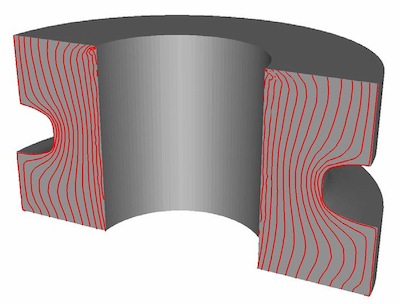Conquering new markets often occurs in link with the growth needs of the business but it is also dictated by developments or even major technological breakthroughs that render certain productions obsolete. To face this challenge, simulation can become an essential asset allowing your engineering to renew and think differently.
Expand product ranges to access new markets
Paradoxically, it may seem simple but at the same time complicated to produce parts in accordance with know-how of the company, but in greater quantity or in more unusual sizes or shapes.
It was the challenge faced by the company FELB Srl specialized in the manufacturing of shaped rings. Faced with a new order taking with nearly 200 rings in A105 steel (10 times more than a standard order), the engineers proposed a solution based directly on the rolling of the shaped ring, without opting for a more traditional process with straight ring and machining. The FORGE® software has thus validated the technical feasibility and the capacities of production equipment to achieve this new type of rings.

“From a CEO point of view, I’m even now noticing interesting returns: we can now expand our business, in terms of batch size and/or complexity of the parts. Advantages on the efficiency on my production processes could be the key to establishing us on these new markets.”
Mr Luigi Catalini, CEO FELB Srl, Italy
Lead significant diversification by engaging in the manufacture of radically new parts
For several years and even more today, car and aircraft manufacturers are faced with strict regulatory requirements in reduction material of emissions. Therefore, their subcontractors are largely oriented towards the production of parts in light alloys such as aluminum. It is in this context that within our clientele, a few years ago a business led a real inner revolution to create a “from 0” complete line of fabrication of aluminium parts intended for the automotive sector.
Without precious experience with this type of alloy, the simulation made it possible to learn ‘quickly and well’ and masterfully produce the components expected in compliance with the requirements of principals.
The simulation allowed among other things to validate flows of material, processing temperatures and sizing of presses.
Tomorrow other companies will be engaged in similar approaches as with the emergence of E-Mobility which impacts the production of parts motorization and transmission. The simulation tool will reinforce the choices of the technical teams and to ensure the success of these diversification!



